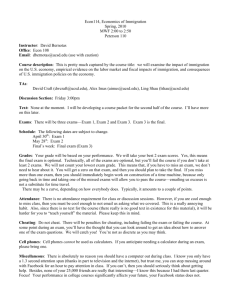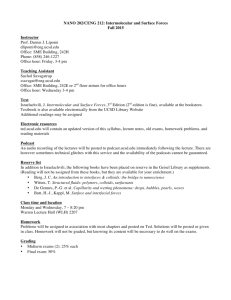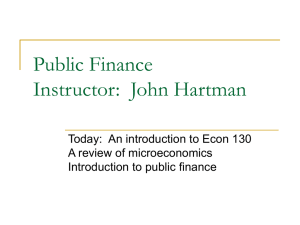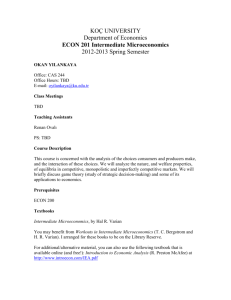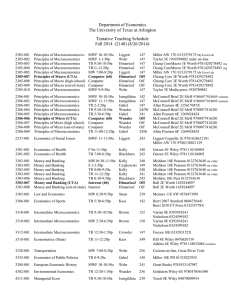ECONOMICS 100A: MICROECONOMICS
advertisement
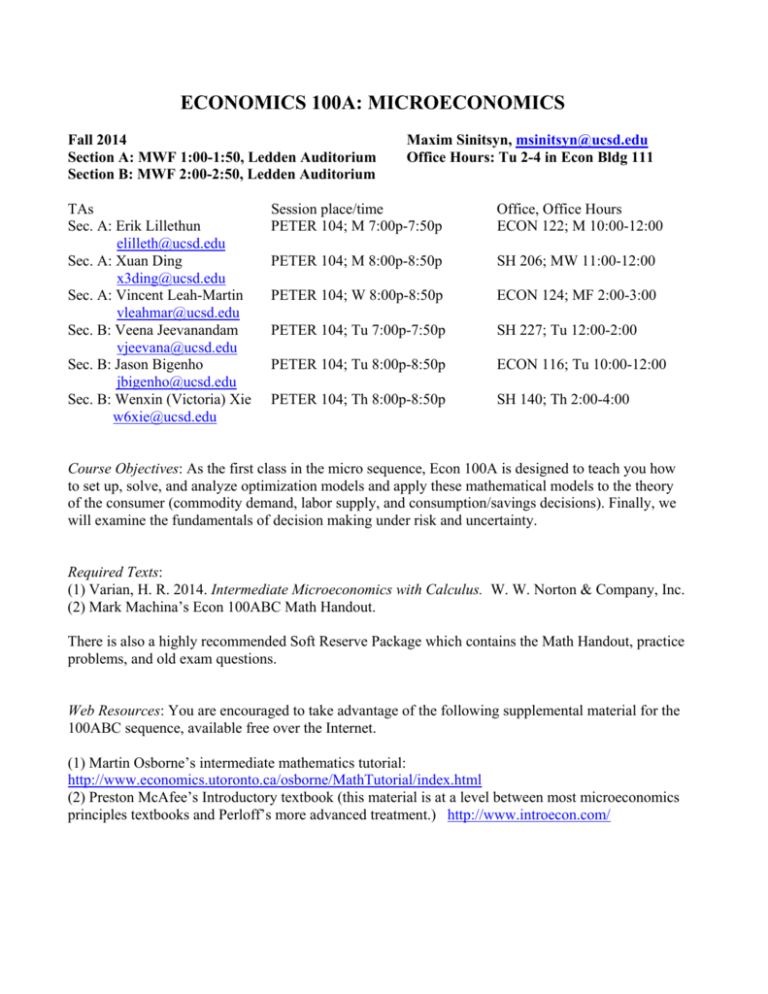
ECONOMICS 100A: MICROECONOMICS Fall 2014 Section A: MWF 1:00-1:50, Ledden Auditorium Section B: MWF 2:00-2:50, Ledden Auditorium TAs Sec. A: Erik Lillethun elilleth@ucsd.edu Sec. A: Xuan Ding x3ding@ucsd.edu Sec. A: Vincent Leah-Martin vleahmar@ucsd.edu Sec. B: Veena Jeevanandam vjeevana@ucsd.edu Sec. B: Jason Bigenho jbigenho@ucsd.edu Sec. B: Wenxin (Victoria) Xie w6xie@ucsd.edu Maxim Sinitsyn, msinitsyn@ucsd.edu Office Hours: Tu 2-4 in Econ Bldg 111 Session place/time PETER 104; M 7:00p-7:50p Office, Office Hours ECON 122; M 10:00-12:00 PETER 104; M 8:00p-8:50p SH 206; MW 11:00-12:00 PETER 104; W 8:00p-8:50p ECON 124; MF 2:00-3:00 PETER 104; Tu 7:00p-7:50p SH 227; Tu 12:00-2:00 PETER 104; Tu 8:00p-8:50p ECON 116; Tu 10:00-12:00 PETER 104; Th 8:00p-8:50p SH 140; Th 2:00-4:00 Course Objectives: As the first class in the micro sequence, Econ 100A is designed to teach you how to set up, solve, and analyze optimization models and apply these mathematical models to the theory of the consumer (commodity demand, labor supply, and consumption/savings decisions). Finally, we will examine the fundamentals of decision making under risk and uncertainty. Required Texts: (1) Varian, H. R. 2014. Intermediate Microeconomics with Calculus. W. W. Norton & Company, Inc. (2) Mark Machina’s Econ 100ABC Math Handout. There is also a highly recommended Soft Reserve Package which contains the Math Handout, practice problems, and old exam questions. Web Resources: You are encouraged to take advantage of the following supplemental material for the 100ABC sequence, available free over the Internet. (1) Martin Osborne’s intermediate mathematics tutorial: http://www.economics.utoronto.ca/osborne/MathTutorial/index.html (2) Preston McAfee’s Introductory textbook (this material is at a level between most microeconomics principles textbooks and Perloff’s more advanced treatment.) http://www.introecon.com/ Weekly Homework: Each week on Friday, I will post practice problems on Ted. They will not be graded. The best way to prepare for the exams is to form study groups and practice doing the problem sets together. I will post the answers after the problems are reviewed in TA sessions. Exams: Grading will be based on two midterms (25% each) and a final examination (50%). The final exam will be cumulative. You must take both midterms. All exams are closed book, and you may not use calculators and cell phones during the exams. Regrade Requests: I will give back the midterm exams in class. You can ask for a regrade before you leave the room with your exam. Your whole exam will be regraded, and your score can go up or down. If you don’t think you have enough time to look at your exam after the class, you can pick up your exam from my office during my office hours. Easter Egg: I planted an intentional mistake into the solution of one of the problems in one of the problem sets. This is a significant conceptual error and not a typo. The first student to find this mistake and successfully explain to me why the solution is wrong (during my office hours) will see his/her score for the final multiplied by 1.11. The first student to offer the correct solution gets the same deal. Schedule: Week Topic Text Ch./Math Handout Section 1 Mathematical Review #1 Sections B and C 2 Consumer Preferences, Utility, Budget Constraint 2, 3, and 4 Midterm 1, October 24; 5:00pm-5:50pm; Solis 107 or Solis 104 depending on the last name 3 Mathematical Review #2 Sections D and E 4, 5 Utility Maximization and Demand Functions 5 and 6 6, 7 Comparative Statics of Demand 8 Midterm 2, November 21; 5:00pm-5:50pm; Solis 107 or Solis 104 depending on the last name 8 Supply of Labor 9 9 Supply of Saving 10 10 Decision Making Under Risk and Uncertainty 12 Final (Sec. A – December 15, 11:30-1:30; Sec. B – December 17, 3:00-5:00) FAMOUS OPTIMIZATION PROBLEMS IN ECONOMICS Optimization Problem Objective Function Constraint Control Variables Parameters Solution Functions Optimal Value Function Consumer’s Problem U(x1,...,xn) utility function p1x1+...+pnxn = I budget constraint x1,..., xn commodity levels p1,..., pn, I prices and income xi(p1,...,pn,I) regular demand functions V(p1,...,pn,I) indirect utility function Expenditure Minimization Problem p1x1+...+pnxn expenditure level U(x1,..., xn) = u desired utility level x1,..., xn commodity levels p1,..., pn , u prices and utility level hi(p1,...,pn , u ) compensated demand functions e(p1,...,pn , u ) expenditure function Labor/Leisure Decision U(H,I ) utility function H, I w, I0 I = I0 + w(168 – H) leisure time, wage rate and budget constraint disposable inc. nonwage income 168 – H(w, I0) labor supply function V(w, I0) indirect utility function Consumption/ Savings Decision U(c1,c2) utility function c1 , c2 I1 , I2, i c2 = I2 + (1+i)(I1– c1) c1(I1, I2, i), c2(I1, I2, i) consumption income stream and budget constraint consumption functions levels interest rate V(I1, I2, i) indirect utility function Long Run Cost Minimization wL + rK total cost F(L,K) = Q desired output L, K factor levels Q, w, r L(Q,w,r), K(Q,w,r) desired output and output-constrained factor prices factor demand functions LTC(Q,w,r) long run total cost function PQ – LTC(Q,w,r) total profit none Q output level P, w, r output price and factor prices Q(P,w,r) long run supply function long run profit function none L, K factor levels P, w, r output price and factor prices L(P,w,r), K(P,w,r) factor demand functions (P,w,r) long run profit function Long Run Profit Maximization (in terms of Q) Long Run Profit PF(L,K) – wL– rK Maximization total profit (in terms of L and K) (P,w,r)

